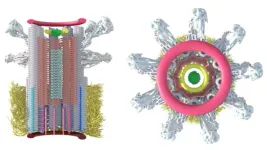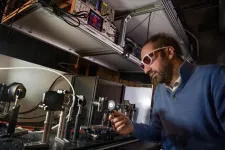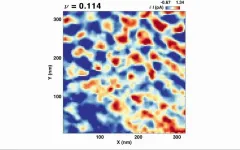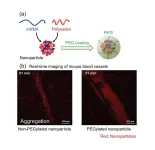(Press-News.org) Cells contain various specialised structures - such as the nucleus, mitochondria or peroxisomes - known as “organelles’’. Tracing their genesis and determining their structure is fundamental to understanding cell function and the pathologies linked to their dysfunction. Scientists at the University of Geneva (UNIGE) have combined high resolution microscopy and kinematic reconstruction techniques to visualise, in motion, the genesis of the human centriole. This organelle, essential to the organisation of the cell skeleton, is associated - in case of dysfunction - with certain cancers, brain disorders or retinal diseases. This work, published in the journal Cell, elucidates the complexities of centriole assembly. It also opens up many new avenues for the study of other cell organelles.
Organelle genesis proceeds according to a precise sequence of successive protein recruitment events. Visualising this assembly in real time provides a better understanding of the role of these proteins in organelle structure or function. However, obtaining a video sequence with sufficient resolution to distinguish such complex microscopic components faces a number of technical limitations.
Inflating cells for better observation
This is particularly true of the centriole. This organelle, measuring less than 500 nanometers (half a thousandth of a millimeter), is constituted of around 100 different proteins organised into six substructural domains. Until a few years ago, it was impossible to visualise the structure of the centriole in detail. The laboratory of Paul Guichard and Virginie Hamel, co-directors of research in the Department of Molecular and Cellular Biology at the UNIGE Faculty of Science, has changed this situation by using the technique of expansion microscopy. This cutting-edge technique enables cells and their constituents to be progressively inflated without being deformed, so that they can then be observed - using conventional microscopes - with very high resolution.
Obtaining images of the centriole with such high resolution enables the exact location of proteins at a given time but gives no information on the order of appearance of substructural domains or of individual proteins. Marine Laporte, a former research and teaching fellow in the UNIGE group and first author of the study, used expansion microscopy to analyse the location of 24 proteins in the six domains in over a thousand centrioles at different stages of growth.
Reorganising images to set them in motion
‘‘This very tedious work was followed by a pseudo-temporal kinematic reconstruction. In other words, we were able to put these thousands of images taken at random during centriole biogenesis back into chronological order, to reconstruct the various stages in the formation of centriole substructures, using a computer analysis we developed,’’ explains Virginie Hamel, co-leader of the study.
This unique approach, which combines the very high resolution of expansion microscopy and kinematic reconstruction, has enabled us to model the first 4D assembly of the human centriole. ‘‘Our work will not only deepen our understanding of centriole formation, but also open up incredible prospects in cellular and molecular biology, since this method can be applied to other macromolecules and cellular structures to study their assembly in space and time,’’ concludes Paul Guichard.
END
The genesis of our cellular skeleton, image by image
UNIGE scientists have reconstructed for the first time a film of the assembly of the human centriole, one of the essential structures that constitute our cells
2024-04-10
ELSE PRESS RELEASES FROM THIS DATE:
Quantum breakthrough when light makes materials magnetic
2024-04-10
The potential of quantum technology is huge but is today largely limited to the extremely cold environments of laboratories. Now, researchers at Stockholm University, at the Nordic Institute for Theoretical Physics and at the Ca’ Foscari University of Venice have succeeded in demonstrating for the very first time how laser light can induce quantum behavior at room temperature – and make non-magnetic materials magnetic. The breakthrough is expected to pave the way for faster and more energy-efficient computers, information transfer and data storage.
Within a few decades, the advancement of quantum technology ...
Living near green space associated with fewer emotional problems in preschool-age kids, NIH study finds
2024-04-10
Children who live in areas with natural spaces (e.g., forests, parks, backyards) from birth may experience fewer emotional issues between the ages of 2 and 5, according to a study funded by the NIH Environmental Influences on Child Health Outcomes (ECHO) program.
While research has suggested that time in nature is important for mental health, studies examining the effects on young children are limited. ECHO investigators addressed this research gap by analyzing information from parents about the behavior of their children from ages 2 to 11. They combined this data with the family’s ...
Researchers explore role of androgens in shaping sex differences
2024-04-10
Sex differences are widespread across human development, physiological processes, and diseases, making it important to characterize the impact of sex differences in these areas. Understanding the regulatory mechanisms associated with these differences, including the role of androgens, is also vital for clinical translation—especially for diseases more prevalent in one sex.
To answer these questions, a team led by Prof. GAO Dong and Prof. CHEN Luonan from the Center for Excellence in Molecular Cell Science, Shanghai Institute ...
Quantum crystal of frozen electrons—the Wigner crystal—is visualized for the first time
2024-04-10
Electrons—these infinitesimally small particles that are known to zip around atoms—continue to amaze scientists despite the more than a century that scientists have studied them. Now, physicists at Princeton University have pushed the boundaries of our understanding of these minute particles by visualizing, for the first time, direct evidence for what is known as the Wigner crystal—a strange kind of matter that is made entirely of electrons.
The finding, published in the April 11th issue of the journal Nature, confirms a 90-year-old ...
A new coating method in mRNA engineering points the way to advanced therapies
2024-04-10
Researchers from Tokyo Medical and Dental University (TMDU) have developed a novel method for chemically modifying engineered messenger RNA molecules, allowing greater control of their biological functions and advancing mRNA therapeutic technologies
Tokyo, Japan – Medicine can help to treat certain illnesses, e.g., antibiotics can help overcome infections, but a new, promising field of medicine involves providing our body with the “blueprint” for how to defeat illnesses on its own.
mRNA therapeutics ...
Stanford Medicine study flags unexpected cells in lung as suspected source of severe COVID
2024-04-10
The lung-cell type that’s most susceptible to infection by SARS-CoV-2, the virus that causes COVID-19, is not the one previously assumed to be most vulnerable. What’s more, the virus enters this susceptible cell via an unexpected route. The medical consequences may be significant.
Stanford Medicine investigators have implicated a type of immune cell known as an interstitial macrophage in the critical transition from a merely bothersome COVID-19 case to a potentially deadly one. Interstitial macrophages are situated deep in the lungs, ...
Studies uncovered why urine sprayed by cats emits a pungent odor
2024-04-10
Cats communicate with others through their scents. One of their scent marking behaviors is spraying urine on vertical surfaces such as walls and furniture. Although spraying plays an essential role in the feline world, it often poses challenges for pet owners because of its strong and pungent odor. Consequently, the website is overflowing with posts discussing the issue of cat spraying. Notably, sprayed urine has a more pungent odor on the human nose than normal urine in their litter boxes. While it is believed that sprayed urine contains additional chemicals possibly ...
Survivors of severe COVID face persistent health problems
2024-04-10
UC San Francisco researchers examined COVID-19 patients across the United States who survived some of the longest and most harrowing battles with the virus and found that about two-thirds still had physical, psychiatric, and cognitive problems for up to a year later.
The study, which appears April 10, 2024, in the journal Critical Care Medicine, reveals the life-altering impact of SARS-CoV-2 on these individuals, the majority of whom had to be placed on mechanical ventilators for an average of one month.
Too sick to be discharged to a skilled nursing ...
New report ‘braids’ Indigenous and Western knowledge for forest adaptation strategies against climate change
2024-04-10
Link to release:
https://www.washington.edu/news/2024/04/10/forest-report/
Link to related coverage:
https://today.oregonstate.edu/news/indigenous-knowledge-western-science-braided-recommendations-land-managers
FROM: James Urton
University of Washington
206-543-2580
jurton@uw.edu
(Note: researcher contact information at end)
For Immediate Release
April 10, 2024
There are 154 national forests in the United States, covering nearly 300,000 square miles of forests, woodlands, shrublands, wetlands, meadows ...
Improving dementia care in nursing homes: Learning from the pandemic years
2024-04-10
INDIANAPOLIS – No one associated with nursing homes – as residents or their families, friends, staff or administrators – is unaware of the massive impact of the pandemic on these facilities which provide essential services to a growing number of older adults, many living with cognitive impairment.
In “Learning from the experience of dementia care for nursing home residents during the pandemic,” an editorial published in the Journal of the American Geriatrics Society, Regenstrief Institute and Indiana University School of ...
LAST 30 PRESS RELEASES:
This self-powered eye tracker harnesses energy from blinking and is as comfortable as everyday glasses
Adverse prenatal exposures linked to higher rates of mental health issues, brain changes in adolescents
Restoring mitochondria shows promise for treating chronic nerve pain
Nature study identifies a molecular switch that controls transitions between single-celled and multicellular forms
USU chemists' CRISPR discovery could lead to single diagnostic test for COVID, flu, RSV
Early hominins from Morocco reveal an African lineage near the root of Homo sapiens
Small chimps, big risks: What chimps show us about our own behavior
We finally know how the most common types of planets are created
Thirty-year risk of cardiovascular disease among healthy women according to clinical thresholds of lipoprotein(a)
Yoga for opioid withdrawal and autonomic regulation
Gene therapy ‘switch’ may offer non-addictive pain relief
Study shows your genes determine how fast your DNA mutates with age
Common brain parasite can infect your immune cells. Here's why that's probably OK
International experts connect infections and aging through cellular senescence
An AI–DFT integrated framework accelerates materials discovery and design
Twist to reshape, shift to transform: Bilayer structure enables multifunctional imaging
CUNY Graduate Center and its academic partners awarded more than $1M by Google.org to advance statewide AI education through the Empire AI consortium
Mount Sinai Health system receives $8.5 million NIH grant renewal to advance research on long-term outcomes in children with congenital heart disease
Researchers develop treatment for advanced prostate cancer that could eliminate severe side effects
Keck Medicine of USC names Christian Pass chief financial officer
Inflatable fabric robotic arm picks apples
MD Anderson and SOPHiA GENETICS announce strategic collaboration to accelerate AI-driven precision oncology
Oil residues can travel over 5,000 miles on ocean debris, study finds
Korea University researchers discover that cholesterol-lowering drug can overcome chemotherapy resistance in triple-negative breast cancer
Ushikuvirus: A newly discovered giant virus may offer clues to the origin of life
Boosting the cell’s own cleanup
Movement matters: Light activity led to better survival in diabetes, heart, kidney disease
Method developed to identify best treatment combinations for glioblastoma based on unique cellular targets
Self-guided behavioral app helps children with epilepsy sleep earlier
Higher consumption of food preservatives is associated with an increased risk of type 2 diabetes
[Press-News.org] The genesis of our cellular skeleton, image by imageUNIGE scientists have reconstructed for the first time a film of the assembly of the human centriole, one of the essential structures that constitute our cells






